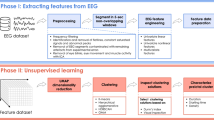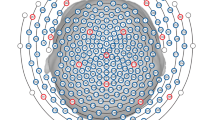Abstract
Fundamental problems in data mining mainly involve discrete decisions based on numerical analyses of data (e.g., class assignment, feature selection, data categorization, identifying outlier samples). These decision-making problems in data mining are combinatorial in nature and can naturally be formulated as discrete optimization problems. One of the most widely studied problems in data mining is clustering. In this paper, we propose a new optimization model for hierarchical clustering based on quadratic programming and later show that this model is compact and scalable. Application of this clustering technique in epilepsy, the second most common brain disorder, is a case point in this study. In our empirical study, we will apply the proposed clustering technique to treatment problems in epilepsy through the brain dynamics analysis of electroencephalogram (EEG) recordings. This study is a proof of concept of our hypothesis that epileptic brains tend to be more synchronized (clustered) during the period before a seizure than a normal period. The results of this study suggest that data mining research might be able to revolutionize current diagnosis and treatment of epilepsy as well as give a greater understanding of brain functions (and other complex systems) from a system perspective.
Similar content being viewed by others
References
Babloyantz A, Destexhe A (1986) Low dimensional chaos in an instance of epilepsy. Proc Natl Acad Sci USA 83:3513–3517
Bertsimas D, Darnell CR, Soucy (1999) Portfolio construction through mixed-integer programming at Grantham, Mayo, van Otterloo and company. Interfaces 29(1):49–66
Bradley PS, Mangasarian OL, Street WN (1997) Clustering via concave minimization. In: Mozer MC, Jordan MI, Petsche T (eds) Advances in neural information processing systems. MIT Press, Cambridge
Chaovalitwongse W, Pardalos PM, Iasemidis LD, Shiau DS, Sackellares JC (2005a) Dynamical approaches and multi-quadratic integer programming for seizure prediction. Optim Methods Softw 20(2–3):383–394
Chaovalitwongse WA, Iasemidis LD, Pardalos PM, Carney PR, Shiau D-S, Sackellares JC (2005b) Performance of a seizure warning algorithm based on the dynamics of intracranial EEG. Epilepsy Res 64:93–133
Chaovalitwongse WA, Pardalos PM, Prokoyev OA (2006) Electroencephalogram (EEG) time series classification: applications in epilepsy. Ann Oper Res 148:227–250
Dunn JC (1973) A fuzzy relative of the isodata process and its use in detecting compact well-separated clusters. J Cybern 3:32–57
Fung GM, Mangasarian OL (2001) Proximal support vector machines. In: 7th ACM SIGKDD international conference on knowledge discovery and data mining
Grossman RL, Kamath C, Kegelmeyer P, Kumar V, Namburu EE (2001) Data mining for scientific and engineering applications. Kluwer Academic, Dordrecht
Hand DJ, Mannila H, Smyth P (2001) Principle of data mining. Bradford Books, Cambridge
Horst R, Pardalos PM, Thoai NV (1995) Introduction to global optimization. Kluwer Academic, Dordrecht
Iasemidis LD (1991) On the dynamics of the human brain in temporal lobe epilepsy. PhD thesis, University of Michigan, Ann Arbor
Iasemidis LD, Zaveri HP, Sackellares JC, Williams WJ (1988) Phase space analysis of EEG in temporal lobe epilepsy. In: IEEE Engineering in medicine and biology society, 10th annual international conference, pp 1201–1203
Iasemidis LD, Pardalos PM, Shiau D-S, Chaovalitwongse WA, Narayanan K, Kumar S, Carney PR, Sackellares JC (2003a) Prediction of human epileptic seizures based on optimization and phase changes of brain electrical activity. Optim Methods Softw 18(1):81–104
Iasemidis LD, Shiau D-S, Chaovalitwongse WA, Sackellares JC, Pardalos PM, Carney PR, Principe JC, Prasad A, Veeramani B, Tsakalis K (2003b) Adaptive epileptic seizure prediction system. IEEE Trans Biomed Eng 5(5):616–627
Iasemidis LD, Shiau D-S, Sackellares JC, Pardalos PM, Prasad A (2004) Dynamical resetting of the human brain at epileptic seizures: application of nonlinear dynamics and global optimization techniques. IEEE Trans Biomed Eng 51(3):493–506
Iasemidis LD, Pardalos PM, Shiau D-S, Chaovalitwongse WA, Narayanan K, Prasad A, Tsakalis K, Carney PR, Sackellares JC (2005) Long term prospective on-line real-time seizure prediction. J Clin Neurophysiol 116(3):532–544
Mangasarian OL (1965) Linear and nonlinear separation of pattern by linear programming. Oper Res 31:445–453
Packard NH, Crutchfield JP, Farmer JD (1980) Geometry from time series. Phys Rev Lett 45:712–716
Pardalos PM, Chaovalitwongse WA, Iasemidis LD, Sackellares JC, Shiau D-S, Carney PR, Prokopyev OA, Yatsenko VA (2004) Seizure warning algorithm based on spatiotemporal dynamics of intracranial EEG. Math Program 101(2):365–385
Rapp PE, Zimmerman ID, Albano AM (1986) Experimental studies of chaotic neural behavior: cellular activity and electroencephalographic signals. In: Othmer HG (ed) Nonlinear oscillations in biology and chemistry. Springer, Berlin, pp 175–205
Takens F (1981) Detecting strange attractors in turbulence. In: Rand DA, Young LS (eds) Dynamical systems and turbulence. Lecture notes in mathematics. Springer, Berlin
Wolf A, Swift JB, Swinney HL, Vastano JA (1985) Determining Lyapunov exponents from a time series. Physica D 16:285–317
Author information
Authors and Affiliations
Corresponding author
Additional information
This work was partially supported by the NSF grant CCF 0546574 and Rutgers Research Council grant-202018.
Rights and permissions
About this article
Cite this article
Chaovalitwongse, W.A. Novel quadratic programming approach for time series clustering with biomedical application. J Comb Optim 15, 225–241 (2008). https://doi.org/10.1007/s10878-007-9117-x
Published:
Issue Date:
DOI: https://doi.org/10.1007/s10878-007-9117-x




